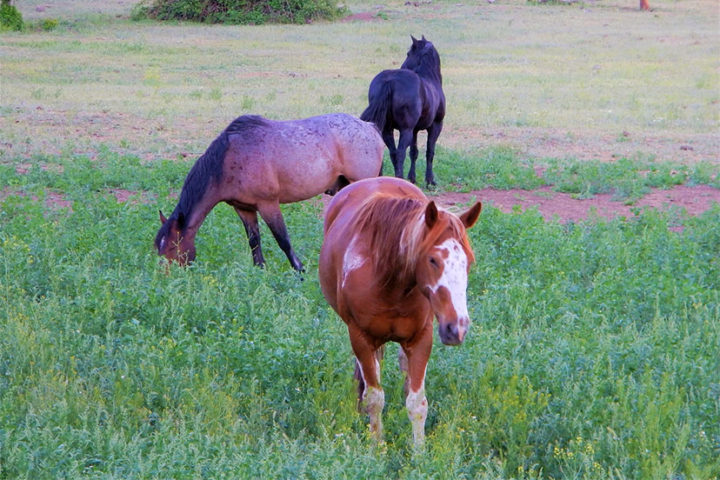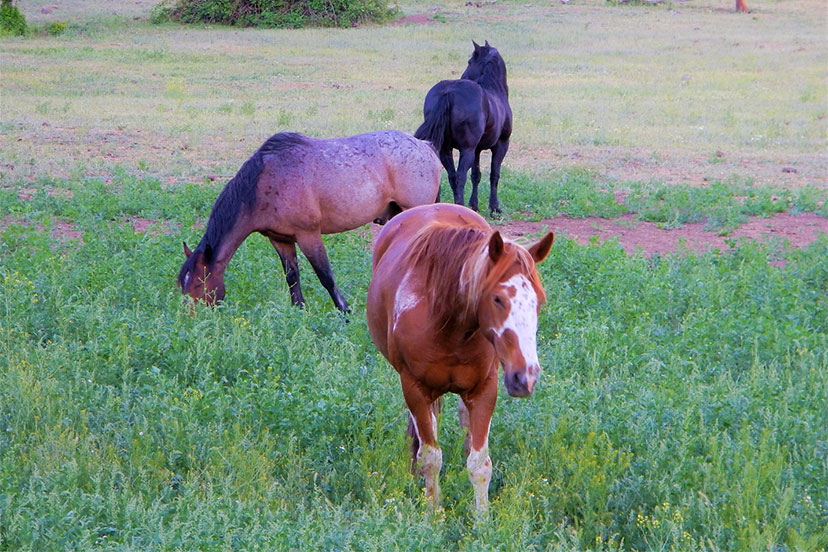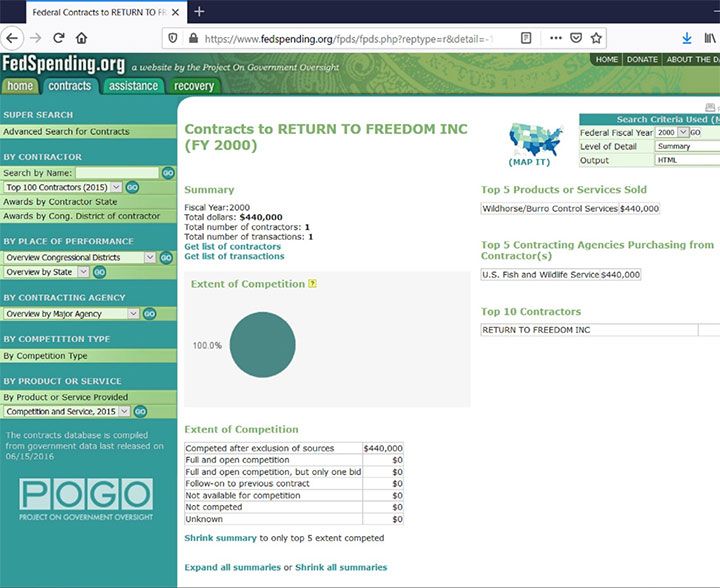Is there a holistic solution for the plight of American wild horses that is both economically and ecologically sensible, and acceptable to a majority of stakeholders?
A recent article at Reason, titled ‘Predictably, Wild Horses Are Still Suffering Due to Federal Slaughter Ban’ stated:
“Turns out that basing animal rights policy on the strong feelings of animal rights activists is not working out so well for the animals themselves”.
While the title of the article seems to imply that America’s wild horses would be better off if there was no ban on slaughter, the statement about the failure of emotionally driven efforts of activists is debatably correct.
The economic argument against slaughter is straight forward and compelling; by our calculations, each wild horse in worth $72,000.00 in a wildfire abatement role. And that thesis is clearly made in a 2-part feature series in the Medford Mail Tribune titled: ‘What is the value of a wild horse’; Part-1, and Part-2
This leaves us with the arguments around the obsolete and misguided policies driving the mismanagement of American wild horses.
After decades of emotionally-driven efforts and tens of millions of donation dollars spent, America’s wild horses are arguably worse off today than anytime in the past 30 years.

It’s is truly sad to see the current plight of America’s wild horses and burros today, which have suffered setback after setback since they were protected in 1971 by the Wild Burro & Horse Protection Act.
In the preamble to the Act, Congress states:
Congress finds and declares that wild free-roaming horses and burros are living symbols of the historic and pioneer spirit of the West; that they contribute to the diversity of life forms within the Nation and enrich the lives of the American people; and that these horses and burros are fast disappearing from the American scene. It is the policy of Congress that wild free-roaming horses and burros shall be protected from capture, branding, harassment, or death; and to accomplish this they are to be considered in the area where presently found, as an integral part of the natural system of the public lands.
As we examine the history of wild horse management since the Act was codified by Congress, we clearly find that there has been government malfeasance in the caring for wild horses and burros under the Act.
Some of the most important intentions of the Act were stated with these words: “wild free-roaming horses and burros shall be protected from capture, branding, harassment, or death…” as well as “as an integral part of the natural system of the public lands.”
Wild horse advocates chasing horses around the landscape with compressed-gas-powered firearms and shooting them with chemicals is technically ‘harassing’ wild horses and arguably illegal under the 1971 Act. Condoning such conduct against wild horses, even as a so-called band-aid, is engaging in willful ignorance and ignoring the solution that is truly the best one for the horses.
Furthermore, there is nothing ‘natural’ about managing wild horses. The definition of natural is that of allowing ‘nature’ and evolutionary processes (including natural selection) to allow wild horses to live in ecological balance in the proper areas… that is, in ‘Wilderness Areas’.
It’s shocking to learn that people working for and at the Bureau of Land Management (‘BLM’) and United States Forest Service (‘USFS’) have either condoned (by inaction) or participated in deeds that are diametrically opposed to the foregoing law, and have allowed or engaged in the ‘capture, branding, harassment or death’ of wild horses and burros. The evidence is staggeringly clear and would convict anyone of such violations in any just court of law.
During roundups, wild horses (and burros) are driven beyond their physical abilities, in many cases; some die from stress during or after the roundups. Foals literally run their hooves off, and some can’t keep up and are lost, left behind for predators. Pregnant mares abort their unborn; some die from shock out on the range; some of these atrocities are concealed from the public.
Clearly, today there are diametrically opposed forces that have faced-off in what some folks see as a type of ‘war’, which has been and continues to be composed of many battles. Individual advocates and non-profit groups have faced-off against the government and each other at times. For instance, there are heated divides between pro-PZP and anti-PZP birth control measure for wild horses.
The wild horse and burro advocacy is aggressively opposing the advocacy for the livestock industry, which also has many supporting organizations who would like more cheap grazing rights on public lands. In the world of business, who could blame them? All businesses strive and compete to reduce the cost of goods produced, and in this instance, meat for the markets.
The competition for all land uses, both public and private has increased due to consumerism, and will continue in years to come. So, the future for wild horses and burros is under pressure, regardless of the 1971 Act. The government on the other hand has to answer (to some extent) to the people for how tax dollars are used, while also balancing demands on public resources and industry; not an easy task by any means, even in a perfect system, which we do not have.
Of course, then there is the competition for donation-dollars by non-profit organizations in regard to the wild horse and burro dilemma and controversy. It’s just a fact that there are only so many donation-dollars available, and non-profits compete, at times quite aggressively, for that money. This alone creates divisions among advocacy groups, where each organization tries to create and maintain a higher ‘status’ in the eyes of potential and existing donors, which at times is done at the expense of other groups or people who are seen as possibly diverting, diluting or eliminating the need for funding. And there is an important distinction that needs to be made clear; there is a difference between non-profit activists whose costs are not used for the direct rescue and long-term sanctuary for wild horses, and sanctuaries that have fixed costs for the long-term care for rescued wild horses and burros.
Some non-profit activists have a business model that includes keeping a token number of wild horses off the range in so-called sanctuaries, which are arguably window dressing for media opportunities and fund-raising purposes. Practically speaking, when thousands of wild horses are being rounded-up and at risk of slaughter, the other approximate 1-2% that are ‘rescued’ really isn’t a game changer for wild horses, which are wildlife, and belong unfettered, wild and free on American wilderness landscapes.
According to an article by Debbie Coffey, V.P. & Director of Wild Horse Affairs, Wild Horse Freedom Federation:
Sadly, as many of you know, Return to Freedom, ASPCA, HSUS, Humane Society Legislative Fund, and the little known American Mustang Foundation (formed by lobbyists in 2016), threw their hats in the ring with many pro-horse slaughter livestock industry organizations, including the National Cattlemen’s Association, on a proposal titled “The Path Forward for Management of BLM’s Wild Horses & Burros” that is really a road to extinction for America’s wild horses and burros on public lands….”
As the saying goes, a leopard never changes its spots, there is a public record showing that Return To Freedom has in the past been paid ($440,000.00) to round up American wild horses, as evidenced in online documents:
Some ranchers who once raised cattle are cashing in on the plight of American wild horses and are now making a very good living off the BLM by warehousing wild horses off-range, costing taxpayers $100 million annually.
Roundups that use helicopters and other vehicles, force wild horses to flee for their lives randomly (abnormal behavioral in response to motorized roundups) across the landscape, and in the process of their desperately fleeing, they inadvertently trample threatened and endangered species of flora and fauna, as do other fleeing wildlife (deer, elk, etc.)
These wide-scale roundups by the BLM and USFS are coupled with the systematic implementation of a combination of diabolical methods that are arguably designed to lead to genetic erosion and loss of genetic diversity, leading to the ultimate extinction of free-roaming native species American wild horses…
The BLM is still engaged in an ongoing campaign of ‘willful ignorance’ and ‘campaign of misinformation’ via their ongoing propagation of manifestly false statements, including but not limited to:
“Wild horses have no natural predators…” This misleading statement promoted by the BLM (and now widely repeated) appears on Page 1, Executive Summary, paragraph 5 in the so-called management plan presented to Congress; ‘Report To Congress: Management Options For A Sustainable Wild Horse And Burro Program’. It’s a well-known scientific and common-knowledge fact that all north American apex predators (mountain lions, bears, wolves and coyotes) are the evolved natural predators of wild horses and burros. We need to restore ecological-balance and the trophic cascades in areas where that is still possible in the remaining remote wilderness areas, where the American wild horse is a critical keystone-species large-herbivore, as is the case in many ecosystems.
History shows anyone who will look; after 46-years since the passage of the Act to protect the wild horses and burros in America, the advocacy, as it is, has not achieved what is needed: a final holistic solution acceptable to a majority of all stakeholders that works for the livestock industry, and also saves wild horses and burros from mismanagement and the resulting atrocities we have all witnessed over the few past decades.
For a discussion about realistic, acceptable solutions, please review this previous Daily Post article concerning the ‘Wild Horse Fire Brigade’.
William E. Simpson II is a naturalist, author, and conservationist living in the Soda Mountain wilderness area among the wild horses that he studies. Learn more at Wild Horse Fire Brigade.


